
For decades, our standard history school textbooks have been filled with Marxist lies and blatant anti-Hindu bias. But what do we replace these pamphlets with, given that the NDA government has initiated no institutional approach to revising the flawed narrative?
One would normally believe that the more hardened an ideologue is, the more difficult it will be for the opposite camp to accept his treatises. In the case of the textbooks of history published by the National Council of Educational Research and Training (NCERT), however, the second generation of leftists, believed to be softer on Marxist beliefs, have disappointed more than their hardcore Communist predecessors.
Something similar to what had happened to Murli Manohar Joshi, the Human Resource Development Minister in the Atal Bihari Vajpayee government, seems to have happened to the younger Marxists. Joshi was heckled so much for ‘saffronising’ education that the book writers commissioned by him ended up with compromised texts with no perspective. Similarly, Arjun Singh of the UPA1 was slammed so much for his ‘detoxification’ drive that UPA2 decided to be more subtle about peddling Marxist history. The result: one only gets fleeting glimpses of our past from the revised curriculum and presentation, all a fine hodgepodge.
The textbook recommended for Class VII, arguably the most controversial of books out of those for the grades from VI to XII, gives the student no sense of the time and space he is in. It comes across as a job done by some history-illiterate clerks who pasted facts at random rather than following the chronology of events.
Qutb Minar built by Qutbuddin Aibak figures along with the Kandariya Mahadeva temple of the Chandelas and the Rajarajeshwara temple in Thanjavur. Instead of dealing with the mosque in the premises of Qutb Minar in the section on the said monument, the mosque surfaces with a detailed diagram after the description of the temples.
In the second chapter called “New Kings and Kingdoms”, which deals with rulers like the Gurjara-Pratiharas, Rashtrakuta and Pala dynasties, Sultan Mahmud of Ghazni pops up out of thin air, as if he were an Indian king rather than an invader. In the chapter on Mughal kings and emperors, Akbar resurfaces after the entire chronology from Babar up to Aurangzeb is over.
Think about the lasting impression an adolescent or youth will get from such a book. Unlike our generation that grew up on Marxist history till the 1980s and yet could recall the order of the monarchies from the Slave Dynasty to the navvabs, zamindars (Muslim and Hindu feudal lords respectively who emerged after the death of Mughal Emperor Aurangzeb) and Maratha campaigners, today’s seventh graders will not be able to visualise the schedule of mediaeval history years after they are no longer in school, or earlier—when they have diversified to science or commerce at the higher secondary or undergraduate level.
Then there are gaps in dates. On page 31 of the book, early Turkish rulers are said to have ruled between 1206 and 1290. But if Ghiyasuddin Balban died in 1287, why are three extra years added to the period? How could the Khalji dynasty have ruled between 1290 and 1320 if Alauddin Khalji died in 1316? How does the period of Tughlaq dynasty span from 1320 to 1414 if Firoz Shah Tughlaq’s reign ended in 1388? How come the Sayyid dynasty is said to have ruled between 1414 and 1451 when the very next line says that Khizr Khan was gone in 1421? If Bahlul Lodi died in 1489, how on earth was the Lodi dynasty’s era 1451-1526?
But the order and timing of historical events is not the only issue with this NCERT textbook. There is an obvious attempt to underplay religious bigotry and despotism of the Islamists.
In the chapter called New Kings and Kingdoms, which deals with rulers like the Gurjara-Pratiharas, Rashtrakuta and Pala dynasties, Mahmud of Ghazni pops up out of thin air, as if he were an Indian king rather than an invader. Asserting that kingdoms in India frequently went to war against each other and that victorious rulers would often plunder the temples of the defeated, it goes on in the same breath to say: “One of the best known of such rulers is Sultan Mahmud of Ghazni, Afghanistan.”One can be sure that Mahmud himself would have been horrified if he knew that one day he would be categorized with Indian kings.
Prithviraj Chauhan is dismissed in one sentence: “The best-known Chahamana ruler was Prithviraja III (1168-1192), who defeated an Afghan ruler named Sultan Muhammad Ghori in 1191, but lost to him the very next year, in 1192.” Again, no mention of invasion. However, quite incredibly, ‘invasion’ crops up when we come to the Delhi Sultanate: “The state was also challenged by Mongol invasions from Afghanistan.” It is of course never mentioned that the Delhi Sultanate itself was set up by Turkish invaders. So the only invaders, according to the textbook, are those who attacked Indian territories captured by foreigners!
If such omissions are not obtrusive enough, the Sikh gurus persecuted and executed through the period of Jahangir, Shah Jahan and Aurangzeb are altogether absent from the book. The book has skipped the death sentence given to the children of Guru Gobind Singh in Aurangzeb’s era, which is remembered as the most diabolical incident perpetrated on Sikhs in the history of the Mughal kings.
There is no mention of the torture Guru Arjan was put through under Jahangir, let alone his execution. The wars Guru Har Gobind fought against Jahangir and then Shah Jahan are absent, as is Guru Har Rai’s persecution by Aurangzeb. The last Mughal emperor—those after Aurangzeb can’t be called emperors—had also summoned Guru Har Krishan to Delhi on a flimsy ground of rebellion. Imagine the mighty empire feeling the heat from a person who died of small pox when he was all of eight, and the NCERT writers do not find a pious young soul serving those affected by the epidemic—and giving up his life in the process—amid harassment by a brutal king worth a mention!
If the Communists could not let these lesser incidents in, how could they recount the persecution, torture, imprisonment and execution of Guru Tegh Bahadur on Aurangzeb’s orders? They simply skipped this guru’s ordeal.
This is not a partisan issue dear only to the Bharatiya Janata Party (BJP). In 2001, Sikhs led by the Indian National Congress’s Arvinder Singh Lovely had taken serious exception to the Satish Chandra-authored history textbook for Class XI, where the Marxist historian had talked of Guru Tegh Bahadur as a plunderer. Mahmud of Ghazni is equated with Indian rulers and Muhammad Ghori was not a plunderer, but Guru Tegh Bahadur is!
Meanwhile every attempt is made to run down Hindu society. After describing the life of a village populated by the ‘lower’ castes, leading—and loaded—questions are asked: “Were there any Brahmanas in this hamlet? Describe all the activities that were taking place in the village. Why do you think temple inscriptions ignore these activities?” When talking about the local administration methods of the Cholas, the Class VII textbook asks: “Do you think women participated in these assemblies?” An entire sub-chapter is devoted to the Chola taxation system, titledFour Hundred Taxes! One is not defending the caste system or gender bias or the taxes the Cholas imposed, but one can certainly ask why the Cholas are singled out for criticism, while the status of women under Islam is never mentioned, and why no Islamic ruler/ dynasty seems to have done anything wrong. In fact, Alauddin Khalji taxing common peasants at 50 per cent of their yields is praised.
Timurlane, whose rapacious military conquests are estimated to have killed 17 million people, or about 5 per cent of the world’s population at that time, is called ‘great’ by the Class VII textbook, while Maharaja Ranjit Singh merits just one laconic sentence: “The Sikh territories in the late eighteenth century extended from the Indus to the Jamuna but they were divided under different rulers. One of them, Maharaja Ranjit Singh, reunited these groups and established his capital at Lahore in 1799.”

What sort of history are our children being taught? We should be worried, very worried. It is not that the NCERT is brazening it out or is blissfully unaware of complaints against its ludicrous narrative. A review meeting was held to discuss the discrepancies in these textbooks last year. The scholars invited to the meet were Prof Meenakshi Jain of the Indian Council of Historical Research (ICHR), JNU’s Prof Pius Malekandathil, Prof Abha Singh of the Indira Gandhi National Open University and the NCERT’s Prof M. Siraj Anwar. Sources in the NCERT say that when Prof Jain pointed out the anomalies in the books in the review meeting, her objections were outvoted 2-1 (Anwar was not supposed to participate in the voting process). Prof Malekandathil and Prof Singh, who voted against Prof Jain, said that the NCERT was, in any event, going to replace the books and, therefore, no major changes could be recommended by this group of experts; only minor errors like some wrong dates could be corrected (but even this has not been done till date). The primary reason the Marxist reviewers gave to Prof Jain for the omissions was “avoidance of strife” in society, which, they said, had been the instruction from the second Manmohan Singh government (UPA2).
But when one looks for reviews of Prof Jain’s books on the internet, the Communists are found deriding her take on Indian history as a “Hindu point of view”. That is indication enough towards the main reason for their reservations about incorporating her viewpoint.
If circumvention of cruel reminders from the past is the best way to avoid strife in society, one would plead with educators internationally that they obliterate every phenomenon from the Ku Klux Klan to the Holocaust, from the crusades to the ongoing jihad. Avoid strife by telling our children that the world has always been a beautiful, harmonious place! Except, of course, under Hindu rulers.
But, again, the problems with NCERT history do not end with the skipping of instances of conflict. Towering personalities who happened to be Hindus have been systematically run down or purged from the record. Chhatrapati Shivaji is belittled as a ‘chieftain’ rather than a ruler, much as the Maratha is till today the most revered human idol in Maharashtra, arguably second in popularity only to the divine Lord Ganpati. Worse, Shivaji is not even a distinct chapter in the book. Before him, let alone the valour of Maharana Pratap, even a reference to the Rana is missing in the leftist narrative of Akbar.
As for disproportionate representation, the Mughal empire was hardly established at the time of Babur, even though he had captured Delhi. His son and successor Humayun had to flee India, unable to live with the onslaughts of Sher Shah Suri. Yet, Babur’s stint in India is glorified with detailed descriptions of the charbagh or four-part gardens he built. What is kept quietly hidden from the schoolchildren is that Babur always considered India a foreign country and in fact hated it, longing to go back to his native Samarkand, or even Kabul, whose cooler climes he loved. In his autobiography, the Baburnama, he wrote:
Hindustan is a country of few charms. There are no good-looking people, there is no social intercourse, no receiving or paying of visits, no genius or manners. In its handicrafts, there is no form or symmetry, method or quality. There are no good horses, no good dogs, no grapes, musk-melons or first-rate fruits, no ice or cold water, no good bread or food cooked in the bazaars, no hot baths, no colleges, no candles, torches or candlesticks.
But to our school textbook writers, Babur is not a foreigner (even though Babur, like Mahmud of Ghazni, would have felt insulted to have been called an Indian) and the Mughal era is an unblemished golden period. And to make sure that the ‘glory’ of the Mughals in the minds of the children is not affected, Sher Shah Suri does not get credit for military strategy, administrative acumen and boost to infrastructure development that our generation had learnt about when we were seventh grade students.
The woes hardly end in the seventh grade. The eighth grade textbook is not a confused mix, unlike the one for the seventh. But the bias of the older Marxists persists with as much gusto. In the answers that the students are implicitly or explicitly encouraged to give to the questions that appear at the end of every chapter, a fixed view is pushed down their throats rather than exhorting them to explore the possibilities, as done in European and American schools.
An example. The Marxists do not like the fact that Jainism and Buddhism, unlike how they are perceived today, were branches of Hinduism, wherein their masters taught Hindus of the period how divinity must be interpreted. They cannot come to terms with the fact that organised religion—marked by one God, one prophet, one book—was not the order of ancient or mediaeval India. From time to time, avatars and preachers emerged, proposing new ways of turning spiritual while this land never observed conflicts of the kind Christians had with Jews, or Muslims had with both Christians and Jews in West Asia and beyond. No Indian of the ancient times asked what an individual’s religion was; they asked one who his guru was, and a distinct school of thought instead of a separate religion was thus identified within one, enormous society. But the Marxists will have none of it. They tell the students that it is totally wrong to mark a period of history as Hindu because “it is this country from where two other religions like Buddhism and Jainism developed and spread to other parts of the world while Hindu religion also existed” (from a website Study Rankers that provides answers to questions from the NCERT syllabi strictly in accordance with the NCERT prescription.)
Then, following the manner in which the Class VII book glossed over the atrocities committed by Mughals and older invaders, the book for Class VIII says nothing about Tipu Sultan’s destruction of the gopurams (gateways) of the Rajarajeshwara temple, forcible circumcision of young Hindus in Seringapatam, deportations and forced conversions of Hindus in Coorg, the torment he subjected the Nairs of north Malabar and Mangalorean Christians to, etc. If indeed it is unfair to slot Tipu either wholly as a pluralist or entirely as a fanatic, why do the scholars who write books for children not tell them that mutually conflicting views on the “Tiger of Mysore” have been expressed by historians of different political shades? Of course, historians like Mohibbul Hasan and Sheikh Ali skate on thin ice here, as Tipu had himself boasted of having forced Hindus to convert or die in the different letters he wrote to Nawab of Kurnool Runmust Khan and Governor of Bekal Badruzzaman Khan, and the inscription on the sword that he presented to Marquess Wellesley.
The Marxists try to balance Tipu’s ruthless Islamism by citing instances like the appointments of Hindus Krishna Rao, Shamaiya Iyengar, Purnaiya, etc. as ministers and the protection given to Sringeri Shankaracharya. Let the students study both. Why remove the parts that inconvenience self-styled secularists?
After finishing the whole of the history for Class VIII, if one were to recall what was taught the previous year, one would also wonder, if the imperialism of the Slaves, Sultans and Mughals was overlooked with glowing tributes to their contribution to art and culture, how come there was nothing appreciable about the British, given that the Marxists in our legislatures, administration and trade unions vehemently oppose any reform that libertarian economists demand in the structure the English rulers left us with. Where contributions to infrastructure, for which the Brits must be thanked, like a decongestion plan for the cities, are mentioned, they are qualified; the appreciation is not categorical. For instance, the Lahore Gate Improvement Scheme is explained with “the British saw overcrowded spaces as unhygienic and unhealthy, the source of disease.” Do you have to be British to infer that congestion is a cause of infections?
Perhaps the Marxist historians and status quoists should sit together in a chamber to settle this paradox. In January this year, the Chief Information Commissioner’s office pulled up the NCERT for chopping contents on Subhas Chandra Bose in the history textbook for Class XII. But injustice to Netaji’s legacy starts four years before a student reaches that level. RTI activist Suryapratap Singh’s queries revealed that 500-odd words on Netaji have been missing from the NCERT book for Class VIII since 2007, while in Class XII, the description was reduced from 1,250 to 87 words. As many as 36 other important non-Congress revolutionaries from the geographical stretch between Punjab in the north-west and Bengal in the east are not mentioned. Swami Vivekananda and Ramakrishna Mission get a mere 26 words. And Sri Aurobindo has vanished!
Forget what we have come to know of Subhas Chandra Bose from the declassification drive of the West Bengal government in 2015 and a bigger revelation of facts by the Centre this year, almost confirming that the hero did not die in an air crash in 1945. The NCERT high school textbooks continue to play down the facts established much before, like the remarkable effort Bose made to put in place the Indian National Army by bringing together Indian prisoners of war (of many different religions) languishing in various parts of the imperial world and the near-victory the force managed to snatch from the British at the Imphal-Kohima stretch (the reason for the defeat was supplies from Japan drying out), which today even British war historians formally acknowledge.
Rather curiously, however, Chapter 7 of the textbook for Class IX deals extensively with the history of cricket and textiles (37 pages). And, yes, eulogies to Nehru and Gandhi are continued with great zeal.
The Council for Indian School Certificate Examinations (CISCE), which conducts the ICSE examination, is a private body. But its character is not quite private, given that private candidates are not permitted to appear for its tests. Furthermore, even a private body must be accountable when it deals with a large mass of people. If the State is questioned for its flawed policies because it is run by taxpayers’ money, a private entity can any day be questioned for corruption that affects many. Distortion of history is a kind of corruption.
This CISCE is no less funny than the CBSE when dealing with history. Recently, Dr Amit Thadhani of the BJP Doctors’ Cell, Mumbai, posted a series of tweets exposing the disproportionate coverage given to insignificant aspects of history and complete denial of the regressive policies of Muslim rulers.
The Class VI textbook of history begins with something even the Marxists of NCERT will squirm to note: an ode to Communist historian Romila Thapar along with her photograph! That is followed by the Aryan Invasion Theory (highly contested, if not debunked, today; see our interview with Indologist Dr Koenraad Elst in the next pages) and the atrocious claim that Buddhism and Jainism preceded Hinduism. Kings of the south—Cholas, Pallavas, etc—are mentioned as Vaishnavas, Shaivyas etc rather than as Hindus. Islamic conquests towards the east and the west of its place of origin (which is now Saudi Arabia) are depicted as a ‘unification’ drive!
Quite simply, if one goes by what the writers of our currently prescribed school textbooks go, there never was such a thing as Hinduism.
But no, that’s not correct. ‘Hindu’ is mentioned when it comes to the caste system. To our writers, Hinduism is caste and nothing more.
To them, all that thinkers and sages from Kabir to Guru Nanak to Basava to Ramanuja to Ramananda to Mirabai to Namdev to Tukaram to Narayana Guru ever did was condemn the caste system. “In one chapter on Hindus of medieval India, no less than eight references to caste system. They’ve hammered it deep, Hinduism means caste,” Thadhani tweeted. This is over and above the ridiculous passing off all acts of Islamic violence as cultural campaigns—at worst, a clamour for wealth—that enriched societies across different regions of the world!
While Maharaja Ranjit Singh gets just four lines, Christianity and Jesus Christ get a full page, replete with religious illustrations (like a halo on the chest of Jesus) and also a downright unscientific claim of Jesus’s ‘healing’ powers!
But are we complaining too much and doing too little? Do we as parents really have no power to change our children’s curriculum of distorted history? Much before this article was conceptualised, at an orientation meeting at the Kothari International School in Noida, the city adjoining Delhi, where my son studies, many parents, I found, were concerned about the fact that the school was not following the ‘board’ religiously. Principal Ms Manju Gupta questioned the parents as to why they were so stuck with CBSE, ignoring the word ‘secondary’ in the term.
Exposed to international standards of pedagogy, Ms Gupta reminded the parents that the Indian State is rigid about what the children are taught only at the secondary—Classes IX and X—level. Below that, an otherwise CBSE-accredited school is free to teach the students anything that somehow leads them to what they will finally learn before appearing for the All India Secondary School Examination or Class X ‘boards’ (which too is now redundant, thanks to former UPA HRD Minister Kapil Sibal). The principals of other schools I spoke to were of the same opinion on individual schools’ autonomy. So, if the parents are by and large worked up about the Marxist tilt in history, the schools can be asked to switch to other versions for Classes VI, VII and VIII—without this action leading to the CBSE sending them showcause notices.
It is the CISCE-accredited schools that must be questioned why their history does not follow the technique that their science education does. Whereas an NCERT book spoonfeeds a child with scientific reasons for things observed around us, a book in a CISCE school describes a phenomenon and then urges the student to visit the library, look for information on the internet, or seek elders’ guidance to know why it happens. Why can’t this method be employed to teach history? The British School in Delhi does it. The American Embassy School does it.
That brings us ultimately to the problem with the political divide. If Marxist history is wrong, what is right? Who will say it? Where has anyone said it? In blogs or social media updates? That is hardly a scholarly, institutionalised or effective way to go about it. Expressing varying degrees of disapproval, Indologists Meenakshi Jain and Koenraad Elst will tell you that the so-called historians in the Sangh Parivar are no historians at all. No, the RSS’s concerns are not bogus; it is their approach to the subject that does not pass muster with serious academia.
The void calls for an institutional approach which, the alarms raised in India’s newspapers notwithstanding, the Modi government is not quite interested in. Sources in the government tell us that its hands are full with (non-)issues raised by cantankerous leftists every other day. It is in no mood to additionally deal with a debate on history, reminiscent of the Atal Behari Vajpayee-Murli Manohar Joshi era.
Sadly, far from being happy with the then HRD Minister Joshi’s efforts, the extreme right had branded the then Prime Minister as ‘Miyan’ Vajpayee. To buy peace with that fringe, among the first things the Modi government did on assuming office was appoint any Sangh-affiliated ‘historian’ to a post he coveted. Before July 2014, how many had heard of Yellapragada Sudershan Rao, the current ICHR chairman? The latest recruitment is Rambahadur Rai as head of the Indira Gandhi National Centre for Arts. While Rai is a fine intellectual and former revolutionary—the first journalist to be arrested during the JP movement—recruitments will not change the way the story of India is told to the future citizens of the country.
Where is the new framework for history education announced by the new government? Where are the new schools of historical studies in universities? We can’t even begin to talk of the conspicuous absence of universities or at least schools dedicated to archaeology, evolutionary anthropology and palaeontology. We have a long way to go before we can catch up with our past.
Source : SWARAJYA

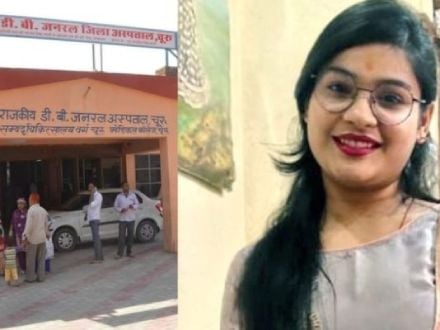 Rajasthan: Woman found hanging at a beauty parlour, Arshad, 3 others booked
Rajasthan: Woman found hanging at a beauty parlour, Arshad, 3 others booked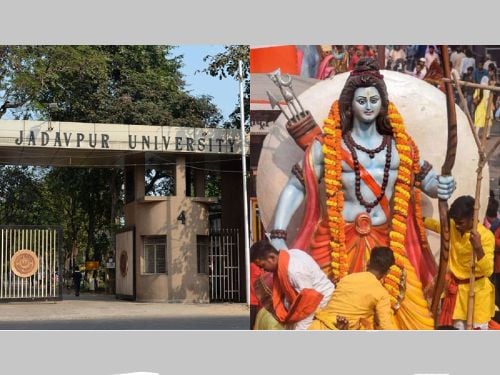 Jadavpur Univ revokes permission to celebrate Ram Navami on campus after granting it
Jadavpur Univ revokes permission to celebrate Ram Navami on campus after granting it Andhra Pradesh: Farooq kills mentally challenged Hindu man for insurance money
Andhra Pradesh: Farooq kills mentally challenged Hindu man for insurance money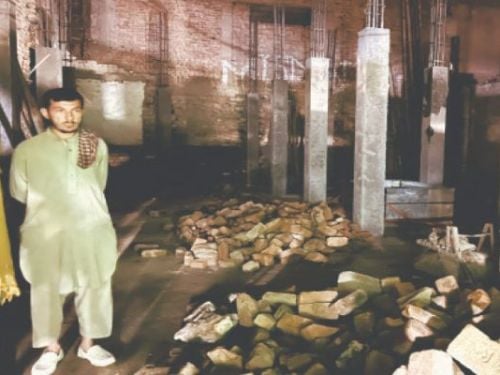 Pakistan: Ancient Hindu temple in Khyber Pakhtunkhwa demolished for commercial complex
Pakistan: Ancient Hindu temple in Khyber Pakhtunkhwa demolished for commercial complex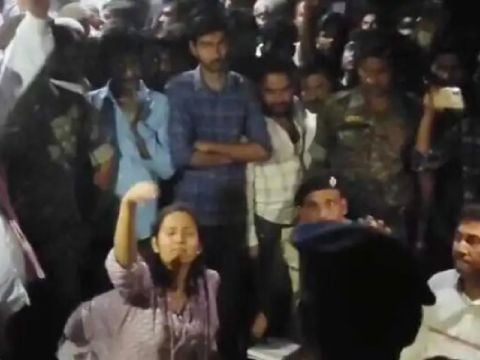 Bihar: Goddess Bhagavati Temple in Araria vandalised and deities damaged
Bihar: Goddess Bhagavati Temple in Araria vandalised and deities damaged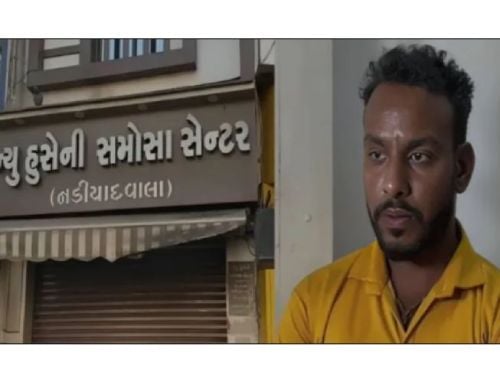 Vadodara: Beef supplier Imran Qureshi arrested in beef-stuffed samosa case
Vadodara: Beef supplier Imran Qureshi arrested in beef-stuffed samosa case